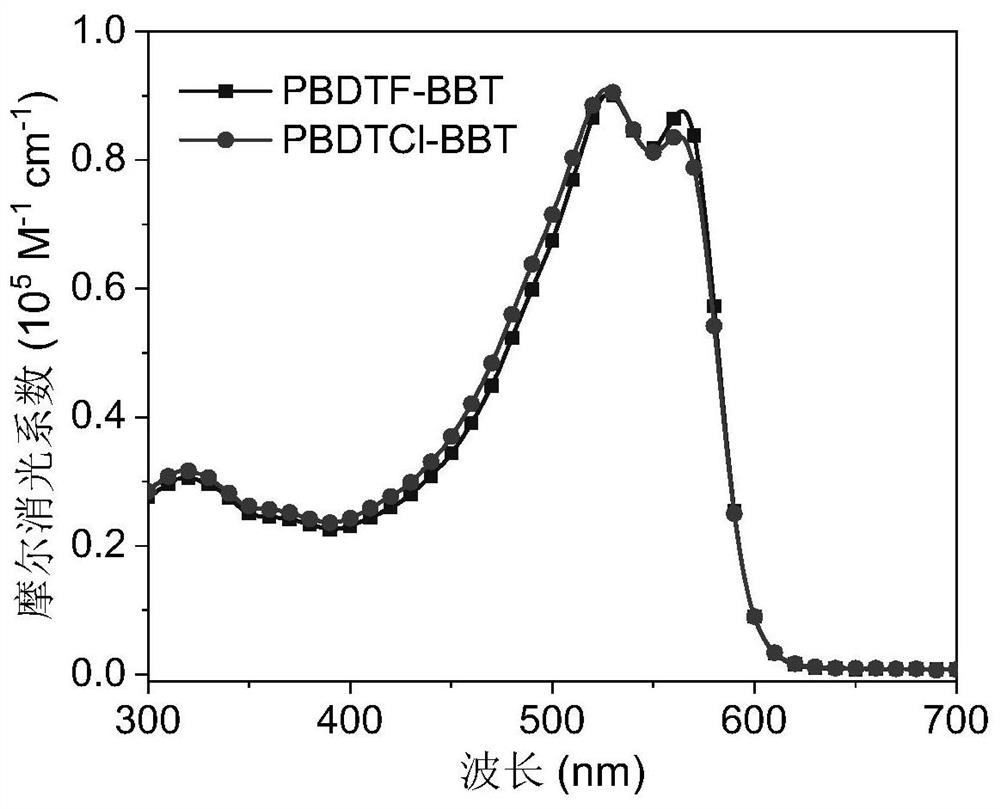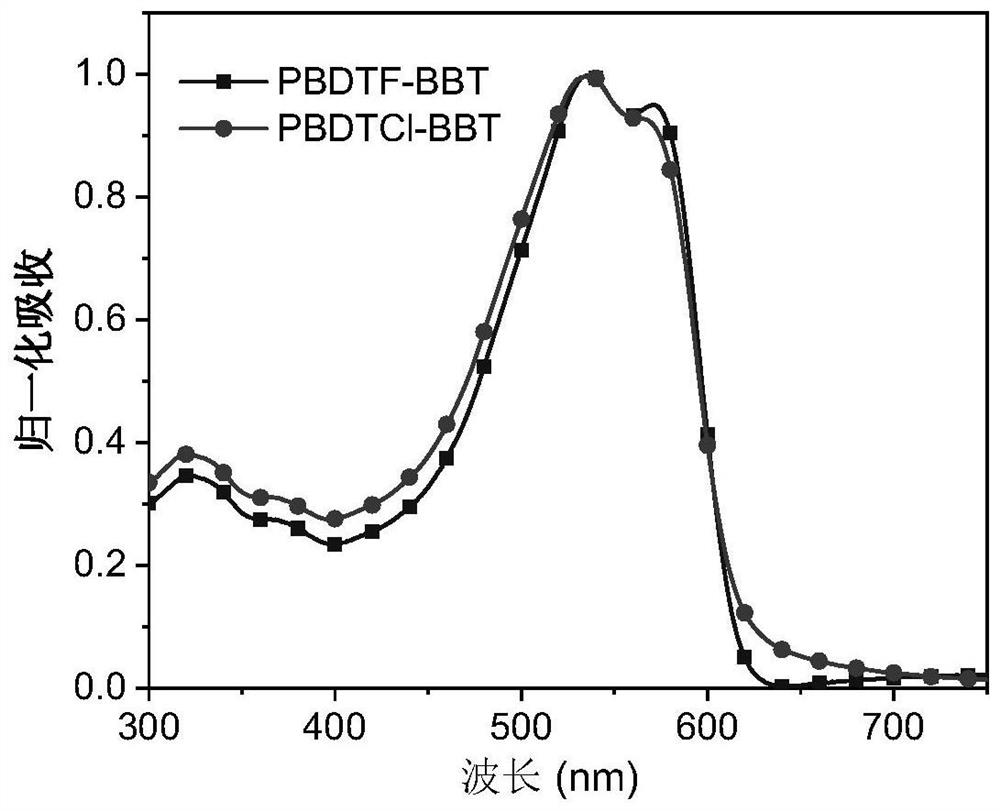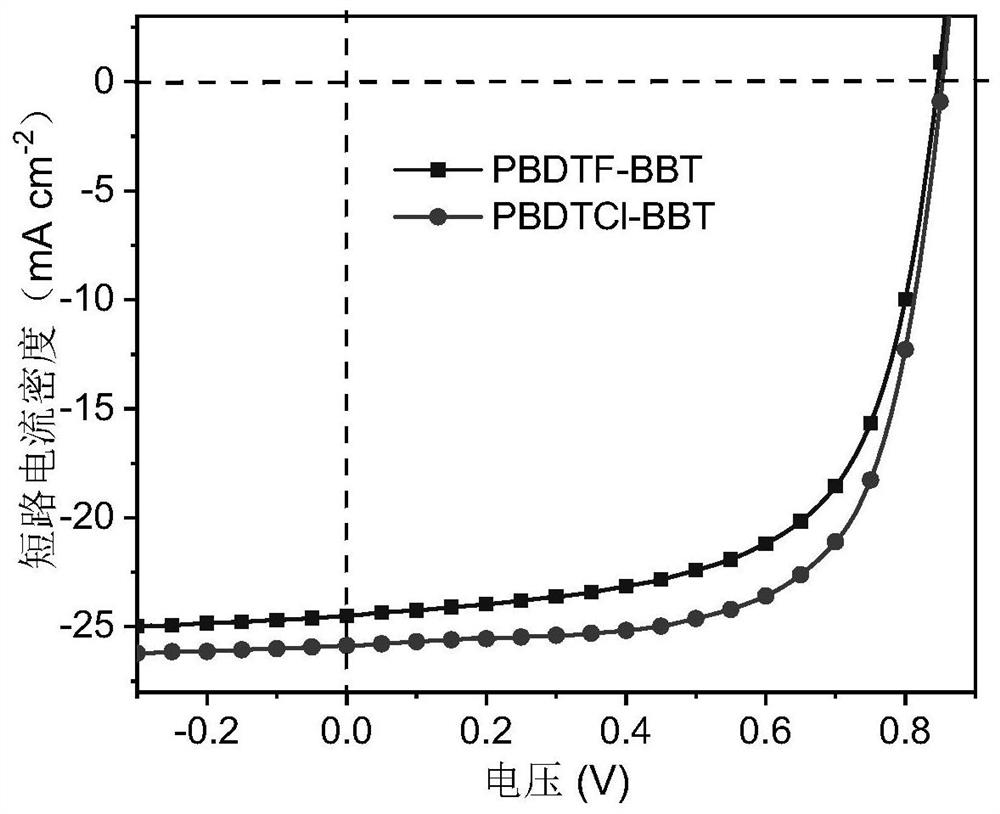Broad-band gap polymer donor material based on benzodithiazole electron-deficient unit and preparation method and application thereof
A benzobithiazole and wide-bandgap technology, which is applied in the field of wide-bandgap polymer donor materials and its preparation, can solve the problems of low carrier mobility, low absorption strength, and poor crystallinity, and achieve reduced steric hindrance, Improves absorption and improves crystallinity
- Summary
- Abstract
- Description
- Claims
- Application Information
AI Technical Summary
Problems solved by technology
Method used
Image
Examples
Embodiment 1
[0042] A monomer BBT-Br based on a benzobithiazole electron-deficient unit containing a thiophene π bridge, the synthesis route is as follows:
[0043]
[0044] Synthesis of compound 3: 2,5-diamino-1,4-benzenedithiol dihydrochloride (2.50g, 10.2mmol) and o-dichlorobenzene (20mL) were added to a 100mL round-bottomed flask, ice Cool in a water bath to 0°C, under the protection of argon, add trimethylsilyl polyphosphate (3.5mL, 27.5mmol) and compound 3 (5.44g, 23.5mmol) in sequence, after the addition is complete, heat to 150°C and react for 24 hours , cooled to room temperature, extracted with dichloromethane, the organic phase was dried with anhydrous magnesium sulfate, suction filtered, and the dichloromethane solvent was removed by rotary evaporation, and the crude product was separated and purified by column chromatography (silica gel, eluent: petroleum ether / dichloromethane=1 / 1, v / v) to obtain 2.47 g of a colorless light yellow oily liquid with a yield of 46%. 1 H NMR (4...
Embodiment 2
[0049] A polymer donor material called PBDTF-BBT, the synthesis route is as follows:
[0050]
[0051] Synthesis of polymer PBDTF-BBT: BBT-Br (0.31g, 0.36mmol) and BDTF-Sn (0.34g, 0.36mmol) were added to a 25mL two-necked bottle, 5.5mL of degassed chlorobenzene was added, and argon protection Add tris(dibenzylideneacetone)dipalladium (6.67mg, 7.29μmol) and tris(o-methylphenyl)phosphine (8.87mg, 29.14μmol) quickly, pump and exchange gas 3 times, and react at 110°C for 6 hours , cooled to room temperature, the reaction solution was dispersed in a beaker with 300mL of methanol, and suction filtered to obtain a red solid, which was extracted by Soxhlet extraction with methanol, n-hexane, acetone, and dichloromethane to remove the catalyst and low-molecular-weight polymers. Soxhlet extraction with chloroform was used to obtain a dark red residual solid, which was placed in a beaker containing 200 mL of methanol, stirred for 30 minutes, left to stand for 2 hours, and filtered wit...
Embodiment 3
[0053] A polymer donor material called PBDTCl-BBT, the synthesis route is as follows:
[0054]
[0055] Synthesis of polymer PBDTCl-BBT: BBT-Br (0.28g, 0.33mmol) and BDTCl-Sn (0.3206g, 0.3290mmol) were added to a 25mL two-necked bottle, 5.5mL of degassed chlorobenzene was added, and argon protection Add tris(dibenzylideneacetone)dipalladium (6.03mg, 6.58μmol) and tris(o-methylphenyl)phosphine (8.01mg, 26.32μmol) rapidly, pump and exchange gas 3 times, and react at 110°C for 6 hours , cooled to room temperature, the reaction system was dispersed in a beaker with 300mL of methanol, and suction filtered to obtain a red solid, which was extracted by Soxhlet extraction with methanol, n-hexane, acetone, and dichloromethane to remove the catalyst and low-molecular-weight polymers. Soxhlet extraction with chloroform was used to obtain a deep red residual solid, which was placed in a beaker containing 200 mL of methanol, stirred for 30 minutes, left to stand for 2 hours, and filtere...
PUM
| Property | Measurement | Unit |
|---|---|---|
| open-circuit voltage | aaaaa | aaaaa |
Abstract
Description
Claims
Application Information
 Login to View More
Login to View More - R&D
- Intellectual Property
- Life Sciences
- Materials
- Tech Scout
- Unparalleled Data Quality
- Higher Quality Content
- 60% Fewer Hallucinations
Browse by: Latest US Patents, China's latest patents, Technical Efficacy Thesaurus, Application Domain, Technology Topic, Popular Technical Reports.
© 2025 PatSnap. All rights reserved.Legal|Privacy policy|Modern Slavery Act Transparency Statement|Sitemap|About US| Contact US: help@patsnap.com



